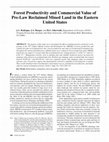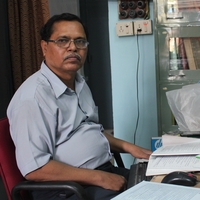Papers by Richard Oderwald
Research performed in the accuracy assessment of remotely sensed data is updated and reviewed. Th... more Research performed in the accuracy assessment of remotely sensed data is updated and reviewed. The use of discrete multivariate analysis techniques for the assessment of error matrices, the use of computer simulation for assessing various sampling strategies, and ...
We would like to acknowledge the support of the Virginia Agricultural Foundation, McIntire-Stenni... more We would like to acknowledge the support of the Virginia Agricultural Foundation, McIntire-Stennis Co-operative Forestry Research Fund, U. S. Forest Service Region 8, and, in particular, personnel of the Jefferson National Forest.
Abstract: The air photo dot-count method is now widely and successfully used for estimating opera... more Abstract: The air photo dot-count method is now widely and successfully used for estimating operational forest area in the USDA Forest Inventory and Analysis (FIA) program. Possible alternatives that would provide for more frequent updates, spectral change detection, and ...

Northern Journal of Applied Forestry, 2002
The purpose of this study was to investigate the effects of mining practices used prior to the pa... more The purpose of this study was to investigate the effects of mining practices used prior to the passage of the 1977 Surface Mining Control and Reclamation Act (SMCRA) on forest productivity and commercial value of reclaimed forest sites. Forest productivity and value of 14 mined and 8 nonmined sites throughout the eastern and midwestern coalfield regions were compared. Forest productivity of pre-SMCRA mined sites was equal to or greater than that of nonmined forests, ranging between 3.3 m3ha-1yr-1 and 12.1 m3ha-1yr-1. Management activities such as planting pine and valuable hardwood species increased the stumpage value of forests on reclaimed mine sites. Rotation-age stumpage values on mined study sites ranged between $3,064 ha-1 and $19,528 ha-1 and were commonly greater than stumpage values on nonmined reference sites. Current law requires that mined land be restored to capability levels found prior to mining. These results should provide a benchmark for reforestation success, pote...
Southern Journal of Applied Forestry, 1982
Point-sampling factors are presented for inside-and outside-bark cubic-foot volume, dry weight, a... more Point-sampling factors are presented for inside-and outside-bark cubic-foot volume, dry weight, and green weight to inside-and outside-bark top diameters for red and white oak and maple in the Appalachian region.
Southern Journal of Applied Forestry, 1979
Center-of-gravity locations and whole-tree weights are useful parameters in both machine design a... more Center-of-gravity locations and whole-tree weights are useful parameters in both machine design and application. Information on the location of the center of gravity for Appalachian hardwood species is provided for both winter and summer condtions.
Southern Journal of Applied Forestry, 1994
The effect on residual tree growth 5 yr after soil rutting caused by a mechanized thinning system... more The effect on residual tree growth 5 yr after soil rutting caused by a mechanized thinning system operating during wet soil conditions was examined in a natural loblolly pine stand. No significant differences were observed when the physical characteristics of the surface 2 in. of sandy loam soil on skidding corridors and untrafficked areas were compared. Diameter growth in the 0-6 ft zone adjacent to corridors was significantly better than the growth observed in the >12 ft zone, but comparisons of other tree characteristics were not significant. Although not recommended, shallow rutting of corridors when soil conditions are wet may not necessarily be detrimental to overall site productivity in spite of the visual impressions immediately after harvesting. South. J. Appl. For. 18(1):24-28.
New emphasis has been placed on the weight of whole trees and portions of trees. Weight inventori... more New emphasis has been placed on the weight of whole trees and portions of trees. Weight inventories and purchase of wood by weight are becoming increasingly common for saw logs as well as pulpwood. More information needs to be gathered on the weight of portions of tree stems, however, before weight can be a standard measurement unit. This information must also be flexible enough to be used with varying utilization standards so that new inventories will not be required when a standard changes. The objective of this study was to develop main stem green and dry weights with and without bark to various top diameters inside and outside bark for red oak, white oak, and maple in the Appalachian region of Virginia.
Thesis--University of Georgia, 1976. Directed by Jerome L. Clutter.
Many people have assisted me, both directly and indirectly, in completing this work. First, I wou... more Many people have assisted me, both directly and indirectly, in completing this work. First, I would like to thank Dr. Robert Giles for his interest in me before and during my course of study. I would also like to thank him for providing me with challenges every day, for encouraging me to cultivate new ideas, and for his assistance in reviewing and improving this thesis. It has been a privilege to work with him. Acknowledgment goes to Dr. Gerald Cross and Dr. Richard Oderwald for their support and advice throughout this project. I also would like to thank the all members of the Department of Fisheries and Wildlife Sciences faculty who have contributed to my improvement as a wildlife professional. I appreciate the financial support for this project provided by the Virginia Gap

Forest Science
Complete, left censored, and left truncated data fitted with a two-parameter complete Weibull dis... more Complete, left censored, and left truncated data fitted with a two-parameter complete Weibull distribution were compared for characterizing complete diameter distributions. The complete data provided the best fit, followed by the censored and truncated data. As the intensity of censoring and truncation increased distribution description was generally poorer. The use of left truncated data was judged unacceptable. Left censored data appears to be a reasonable alternative to complete data. In field applications collection of left censored data would reduce measurement time. Complete, left censored, and left truncated data fitted with a two-parameter complete Weibull and left truncated data fitted with a two-parameter left truncated Weibull were compared for characterizing left truncated diameter distributions. The left truncated data fitted with a left truncated Weibull performed best, but no data type-distribution combination worked well for inverse j-shape distributions. Forest Sci....
Forest Science
The Weibull distribution is presented as a flexible model of survival in even-aged stands. The da... more The Weibull distribution is presented as a flexible model of survival in even-aged stands. The data necessary for both the complete and censored Weibull distribution and their applications are discussed. A case study is presented using the Weibull distribution to model survival in even-aged stands of loblolly pine from ages 3 to 14. Within the limitations of the data an adequate model was obtained. Forest Sci. 26:291-300.
Forest Science
The König-Faustmann form of marginal analysis derives a valid estimate of the financially optimal... more The König-Faustmann form of marginal analysis derives a valid estimate of the financially optimal rotation for individual trees and other indivisible forest capital: forests whose age-class structure is not to be changed. For divisible capital, the applicable form of the marginal model derives a shorter rotation because it allows for interactions among forest compartments. For. Sci. 36(1):169-174.

Forest Science
Mapped-stand data which includes tree location and mensuration data may be used to simulate the h... more Mapped-stand data which includes tree location and mensuration data may be used to simulate the height characteristics of a forest canopy in a computer. The dimensions of the rectangular, fixed-area ground plot which is used to collect the tree location and mensuration data can profoundly affect the accuracy of the resultant computer reconstruction of forest canopy heights. Thin fixed-area plots result in forest canopy height constructs (i.e., canopy height models, or CHMs) which are shorter and less dense than the actual forest stand. Ninety-nine 0.405 ha forest stands in the southeastern and south central United States were analyzed. For each stand, a top-of-canopy height model was generated for the entire stand on a 0.25 m x 0.25 m grid. The mean canopy height and the canopy density of the simulated stand was calculated. A Monte Carlo simulator established randomly located sample plots of varying plot width (1 m to 20 m) at three different sampling intensities (1%, 5%, and 10% of...
Remote sensing technologies have tremendous potential for day-to-day field use, but on-the-ground... more Remote sensing technologies have tremendous potential for day-to-day field use, but on-the-ground foresters have thus far not been able to embrace them. One reason is that field foresters require information, not images, and that information must be applicable for small timber sales and management units. To make the technology useful, remote sensing specialists need to develop "turnkey" programs that ask what results are needed and then access the necessary images, suggest ground sampling strategies and measurements, apply the appropriate algorithms, and report results.
Leisure Sciences, 1980
ABSTRACT Simulated unequal probability samples were drawn from a known population to compare with... more ABSTRACT Simulated unequal probability samples were drawn from a known population to compare with‐replacement and without‐re‐placement sampling procedures. Results indicate that the gains in variance from without‐replacement sampling are not sufficient to offset the computational difficulties.
Southern Journal of Applied Forestry
Stratification with proportional allocation can reduce the number of plots needed or improve accu... more Stratification with proportional allocation can reduce the number of plots needed or improve accuracy in a cruise. The greatest gains from stratification occur when the stratum volumes per acre are very different, and the stratum sizes are equal. A formula for calculating the gain from stratification with proportional allocation is given. The gain from two strata with three levels of relative stratum size is shown. An example is calculated for three strata. Criteria for number of strata and stratum selection are discussed. South. J. Appl. For.:17(2):96-99.











Uploads
Papers by Richard Oderwald